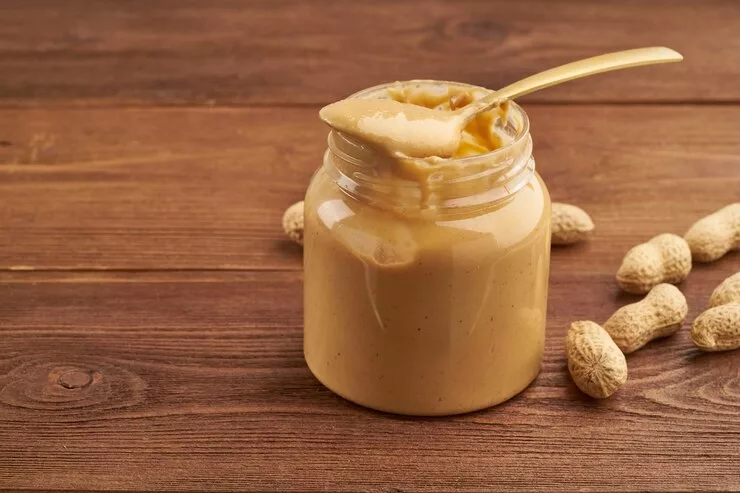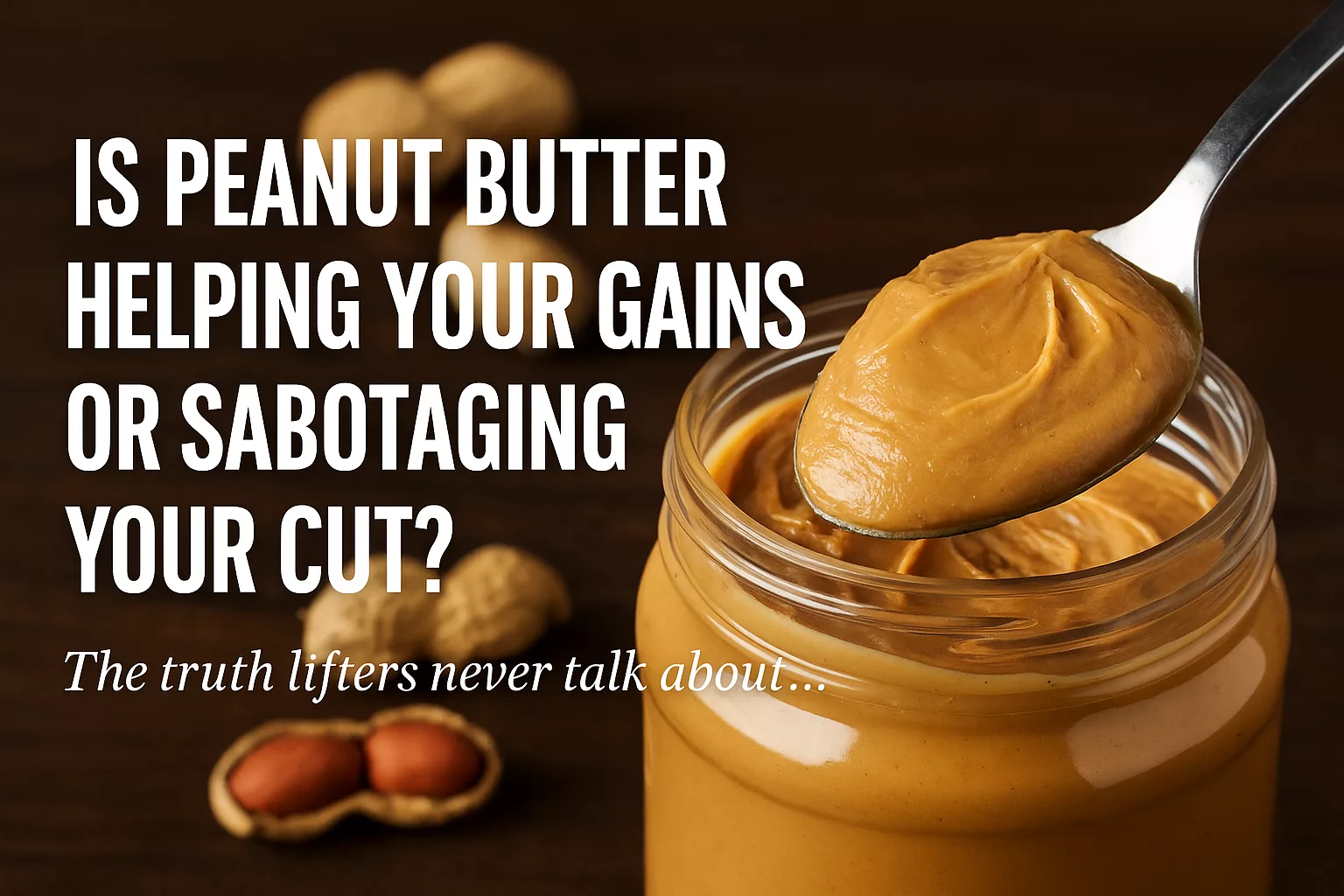I admit it: when I started lifting weights, peanut butter was practically the Holy Grail of fitness for me.
One spoonful and you already felt bigger.
Thick, creamy (or crunchy, if you’re a borderline type), sweet just right, and with those calories going straight into your muscles… or so I thought.
But the truth? It depends.
It depends on WHAT you’re doing in the gym, HOW you eat everything else during the day, and above all, HOW MUCH you eat.
Because that innocent-looking spoonful can become the coup de grâce to your calorie deficit.
And trust me, nobody wants to discover after three weeks that they sabotaged their cut with a forkful here and there in front of Netflix.
Peanut butter: faithful friend or silent betrayer?

Let’s be clear.
In two tablespoons of peanut butter, on average:
- 190–200 calories
- 16 grams of fat
- 7–8 grams of protein
- About 6 grams of carbohydrates (with at least 1–2 grams of sugar)
And no, you’re not eating just “two tablespoons.”
I know it, you know it, even the jar’s lid knows it—always ends up greasy.
Peanut butter is one of those foods that seem innocent… but have a very high rate of hidden calories.
You think you’ve had a light snack, but you’ve basically eaten the caloric equivalent of a plate of pasta—without even feeling full.
In bulking? Sure (but use your brain)

If you’re trying to put on mass and you’re one of those who struggle to hit daily calories—like a scrawny hardgainer who burns even their tears—peanut butter can be a godsend.
It’s convenient, requires no cooking, tastes great, and easily adds 300–400 calories with a simple snack.
Plus, it contains “good” fats (monounsaturated and some polyunsaturated), useful for supporting hormone production, particularly testosterone, which we all know is important for muscle growth.
It also provides some vitamin E, magnesium, niacin, and antioxidants.
But watch out: it’s not a high-quality protein source.
The proteins in peanut butter are incomplete (missing some essential amino acids), and alone they’re not enough to stimulate muscle protein synthesis.
So don’t fool yourself: you can’t treat it like chicken blended into a cream.
It’s a complement, not the foundation.
During the cut? Watch out for slipping

Here everything changes.
When you’re in a cutting phase and you have a ridiculous calorie budget like “1,800 kcal plus some cardio,” peanut butter becomes dangerous.
Yes, dangerous.
Because two tablespoons can take away 10–15 % of your daily calorie intake… without filling you up, without satisfying you, and without providing much protein.
It’s like paying €50 for a bottle of water at a festival: it quenches you for two minutes, then you’re broke and still thirsty.
If you absolutely can’t give it up, it must be dosed with surgical precision.
Kitchen scale in hand, killer stare, and zero emotions.
Because the moment you let your guard down… the spoon transforms into a lethal weapon against your progress.
“But I use the natural one!”
Classic line.
“Don’t worry bro, mine has no added sugars, it’s all organic, 100 % peanuts.”
Fantastic.
You might have saved 2 grams of sugar, but everything else is practically the same.
- Calories? Identical.
- Fat? Same.
- Protein? Pretty much there.
So let’s stop justifying binges by saying it’s “natural.”
Coconut oil is natural too, but you wouldn’t scoop it by the spoon thinking it makes you lose weight.
The real difference is context.
How I use it, without fooling myself
In a bulk? Yes.
I put it in post-workout smoothies (with banana, oats, protein), spread it on whole-grain bread or rice cakes, even use it to make protein pancakes.
But I track it. Always.
No flying spoons. No “I just licked it.”
Every gram counts. And if the next day I’m 400 grams heavier… I know exactly who to blame.
In a cut? I practically eliminate it.
At most, I use it occasionally as a “psychological reward” to stay sane.
A thin layer on a rice cake, maybe in the evening, when I’ve already hit all my macros and have 100 kcal left.
But I treat it like a luxury.
Like a glass of wine on keto: if you must, do it carefully and savor every drop.
A look at the data, just to be serious for a moment
A lot of people say that eating plenty of monounsaturated fats can boost testosterone and help with muscle growth.
Sounds good on paper—but real-world data says otherwise.
A large study on middle-aged men found no clear link between monounsaturated fat intake and testosterone levels.
Saturated fats showed a slight positive effect at first, but it disappeared after adjusting for other lifestyle habits.
But eating fats alone won’t make you big.
If your protein intake is low or your training is weak, you can eat all the peanut butter in the world: it changes nothing.
Context decides. Always.
Peanut butter can help you reach your goals if it’s part of a coherent plan.
It won’t get you there on its own.
Peanut butter alternatives when you want to save calories
If you love the taste but you’re cutting or just want something more “macro-friendly,” there are alternative options that save both flavor and your waistline.
- Powdered nut butter (like PB2): less fat and about 70 % fewer calories. Just add water and it’s ready. It doesn’t taste exactly the same, but it comes pretty close.
- Flavored protein spreads: some brands offer peanut butters enriched with isolated proteins. More expensive, but often more balanced macros.
- Greek yogurt with a pinch of cocoa and sweetener: not peanut butter, but if you want a creamy, protein-packed snack, it’s an excellent alternative.
- Tahini or almond butter? Not always better. They’re still rich in fats. But note: almond butter has more magnesium and vitamin E, so it can be worth rotating occasionally.
How to pair it intelligently in meals
One key to not derailing your diet with peanut butter is integrating it into a well-balanced meal, not using it as a standalone snack.
- Pre-workout breakfast: A slice of whole-grain bread with peanut butter and a banana. Great combo of slow-release carbs, fats, and natural sugars for lasting energy.
- Post-workout shake: Whey, banana, oats, and a spoonful of peanut butter. Helps you bump up calories after an intense session.
- Evening “calming” snack: If you tend to nibble at night, use a thin layer on a rice cake plus a pinch of cinnamon. Satisfies your sweet tooth without wrecking your macros.
The psychological problem: why peanut butter tricks us
It’s not just about calories: peanut butter is one of those foods that stimulate compulsive behavior.
The sweet-salty taste, creamy texture, and easy access make it hyper-palatable.
In short: the brain interprets it as “super rewarding,” and pushes you to want more.
It’s the same mechanism as industrial snacks.
If you tend to eat out of boredom, stress, or habit, peanut butter becomes an emotional trap: it comforts you, consoles you… and sabotages you.
Practical tip?
Never eat it straight from the jar. Ever.
Measure your portion on the scale, put the jar away, walk away, and then eat. It sounds trivial, but it changes everything.
RELATED:》》》Does Chugging Milk Pre-Workout Really Help You Gain Muscle Faster?
Is Peanut Butter a Myth or a Muscle-Building Ally for the Heavy Lifters?
If you’re in a bulk: use it, love it, but use it wisely. It gives you extra calories easily, but it must be tracked.
If you’re in a cut: use it only if you have room in your macros and are willing to sacrifice a more voluminous meal for a spoonful of pleasure.
It doesn’t work miracles.
It’s not an enemy.
It’s just a food.

